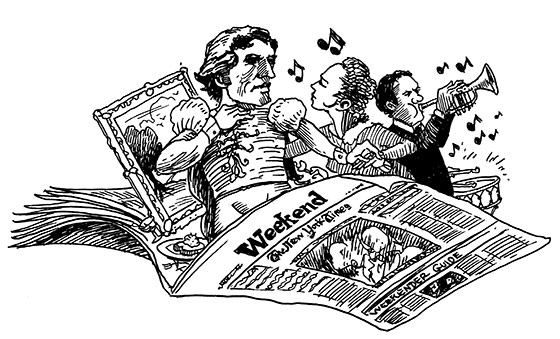
One day, [senior vice-president Walter] Mattson and John Pomfret, assistant general manager of The Times, met with Abe [Rosenthal, managing editor] and me to urge us to proceed with the planning of the first four-section paper as soon as possible. Things had gotten so bad, Pomfret said, “the company is making less money from its newspaper than from the paper mills it owns.” Abe insisted that the only way to draw more circulation and advertising was to create sections so inviting that they would become “must reading”—a goal requiring an investment of added space and a talented staff. “When a newspaper like ours needs help in difficult times,” he said, “the best way to nourish it is not by watering the soup but by enriching it with more meat and tomatoes.”
It was section three that initially stumped Abe and me and led to our first contretemps with advertising department executives. They suggested it be a daily style section, featuring fashion. Abe, [art director] Lou Silverstein and I were dead-set against that concept. In the first place, we insisted there had to be a different third section each day, Monday through Friday—and Mattson and Pomfret finally accepted our plan. We agreed we would introduce the sections one at a time, waiting until each was successfully established, before moving on to the next.
Having rejected a fashion section, we began casting about for broader more inviting topics that would appeal to the younger educated reader. The newly commissioned surveys confirmed our intuition that our young readers, while acknowledging The Times as the authoritative source of news, wanted coverage that would enrich their daily lives, particularly their weekends. Mattson told us that the Miami Herald recently had achieved success with such a weekend section.
Abe himself noted that The Times lagged in meeting readers’ interests in this area. “Times people themselves confirm this,” he wrote in one memo to Punch [Sulzberger, publisher]. “They turn to other publications, like The New Yorker, New York magazine and Newsday for their needs. These publications not only give them the information but achieve a kind of intimacy and affection with their readers because through this kind of service, they relate to the happy and upbeat part of their readers’ lives. Moreover, the service information relates directly to the readers who mean most to us—and to advertisers—the young and affluent.”
Thus we decided, in early 1976, that the first of the new sections would appear on Fridays, and would contain commentary, criticism, feature stories, columns and service listings about what the city had to offer on the weekend, hence its name: Weekend. The section would be devoted mainly to the arts and to entertainment events, and Abe asked me to take charge of creating Weekend and the four sections to follow.
When the [Weekend] section came off the press … Abe pronounced himself pleased. The next morning, however, Lou and I heard not a word from any other editor. We told each other that judgment was probably being withheld until the public reacted. Sydney Schanberg and a couple of metropolitan reporters let us know they didn’t think much of the section. And a few reporters grudgingly said it “seemed okay.” It was so different from anything that had ever been part of the daily paper that the staff evidently didn’t know how to assess it.
I decided to cheer myself up by arranging a last-minute party to celebrate our new baby. With Abe’s encouragement, I booked Sardi’s private Belasco Room that evening for a cocktail party, and then flipped through my Rolodex and personally invited as many theater, literary and television personalities as I could reach. At the party, some of the Times people had heard that Abe liked the section but I was told by a friend that there were those who had sourly commented that it was just a case of “Abe and Arthur” sticking together again. I went up to the Punch at the buffet table and asked him what he thought. “Only time will tell,” he said. I gulped.
Reprinted from City Room, by Arthur Gelb, with permission of G.P. Putnam Sons, a division of the Penguin Group USA. Copyright 2003 by Arthur Gelb.